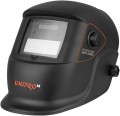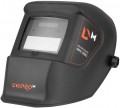Light filtering levels
The degree of light penetration provided by the mask filter, in other words, the degree of darkening (light attenuation) provided by the product.
The degree of dimming is indicated in DIN units, the larger its value, the lower the light transmission (that is, the darker the filter). Note that for chameleon masks (see "Type"), this paragraph indicates the characteristics of the light filter in the off state — that is, when it is not darkened and as transparent as possible. So for such products, the degree of light penetration is more of a reference value, and it is necessary to evaluate the actual degree of protection in "chameleons" by the minimum and maximum degree of dimming (see below).
In turn, for masks and glasses with permanent filters, the degree of light penetration is the main performance characteristic. Here you need to proceed from the following: a darker filter, on the one hand, provides higher protection against bright light, on the other hand, worsens visibility. So the optimal values for most welding work are 10 – 12 DIN, it is in this range that the characteristics of most modern masks / goggles without the "chameleon" function lie. More detailed recommendations on the optimal transparency of light filters for different situations can be found in special sources.
Min. degree of darkening
The smallest degree of obscuration provided by the chameleon mask (see "Type") when the light filter is activated. Recall that dimming is indicated in DIN units, the larger the number in this paragraph, the darker the filter.
This parameter is indicated only for models with dimming control (see "Functions"). From the minimum degree of dimming depends on the extent to which you can adjust the light transmission. At the same time, we recall that a darker light filter protects better from bright light, but worsens visibility; so for some tasks, a relatively low level of obscuration may be optimal. Accordingly, the lower this indicator, the wider the adjustment range of the filter, the more opportunities the user has to adjust it (with the same maximum threshold). On the other hand, the expansion of the adjustment range significantly affects the cost, and such characteristics are not always required. Therefore, nowadays, you can find chameleon masks both with a small (
5 DIN and even
less), and with a fairly significant minimum dimming (
7 DIN or even
9 DIN). And it’s worth choosing here, depending on what is more important for you: an extensive range of adjustment or low cost.
Max. degree of darkening
The greatest degree of obscuration provided by the chameleon mask (see "Type") with the filter activated. For models that do not have dimming adjustment (see "Functions"), this item indicates the standard level of light transmission of the included light filter.
Recall that dimming is indicated in DIN units, the larger the number in this designation, the darker the filter. In turn, a darker mask gives better protection from bright light, but worsens visibility; Accordingly, different degrees of dimming may be optimal for different tasks. Detailed recommendations on this matter can be found in special sources; Here we note a few general points. So, the minimum indicator necessary for safe work with electric welding is
10 DIN ; as a consequence, this is the smallest value of maximum dimming that can be found in modern "chameleons". And most of these masks have higher levels of the greatest dimming —
11 DIN,
12 DIN, or even
13 DIN.
Operating temperature
The range of ambient air temperatures at which the mask is guaranteed to be able to function normally. This parameter is especially important for "chameleons" (see "Functions"), because. the performance of the automatic filter directly depends on external conditions (in particular, at low temperatures, the response time may increase).
Darkening adjustment
The ability to manually select the degree of darkening of the filter in the chameleon mask. This feature is found mainly in professional models; it allows the welder to manually adjust the light transmission for specific conditions. The need
to adjust the dimming is due to the fact that for some types of work (for example, TIG welding of ferrous metals), the brightness of the arc is relatively low, and in order to see the weld pool normally, dimming of only 8-9 DIN is enough instead of the usual 12 DIN or more .
Grinding mode
A special mode of operation of the chameleon mask, in which the light filter sensors are completely turned off — thus, it constantly remains transparent and does not respond to any flashes. This mode is useful for jobs that can produce fairly bright flashes of light, but do not require dimming. A classic example of such work is grinding with a “grinder” or a machine tool, when sparks can fly from the workpiece; hence the name of this function —
"grinding" mode.
Design features
— Backlight. Illumination system built right into the mask. This feature is very convenient when working in low light conditions: the backlight does not take up the hands (unlike hand-held flashlights) and does not create problems with wearing a mask (unlike headlamps), while the beam of light is always directed to where the welder's head is turned. On the other hand, such a system requires its own power supply. Therefore, it is used only in "chameleons", while the operation of the backlight additionally consumes battery power.

